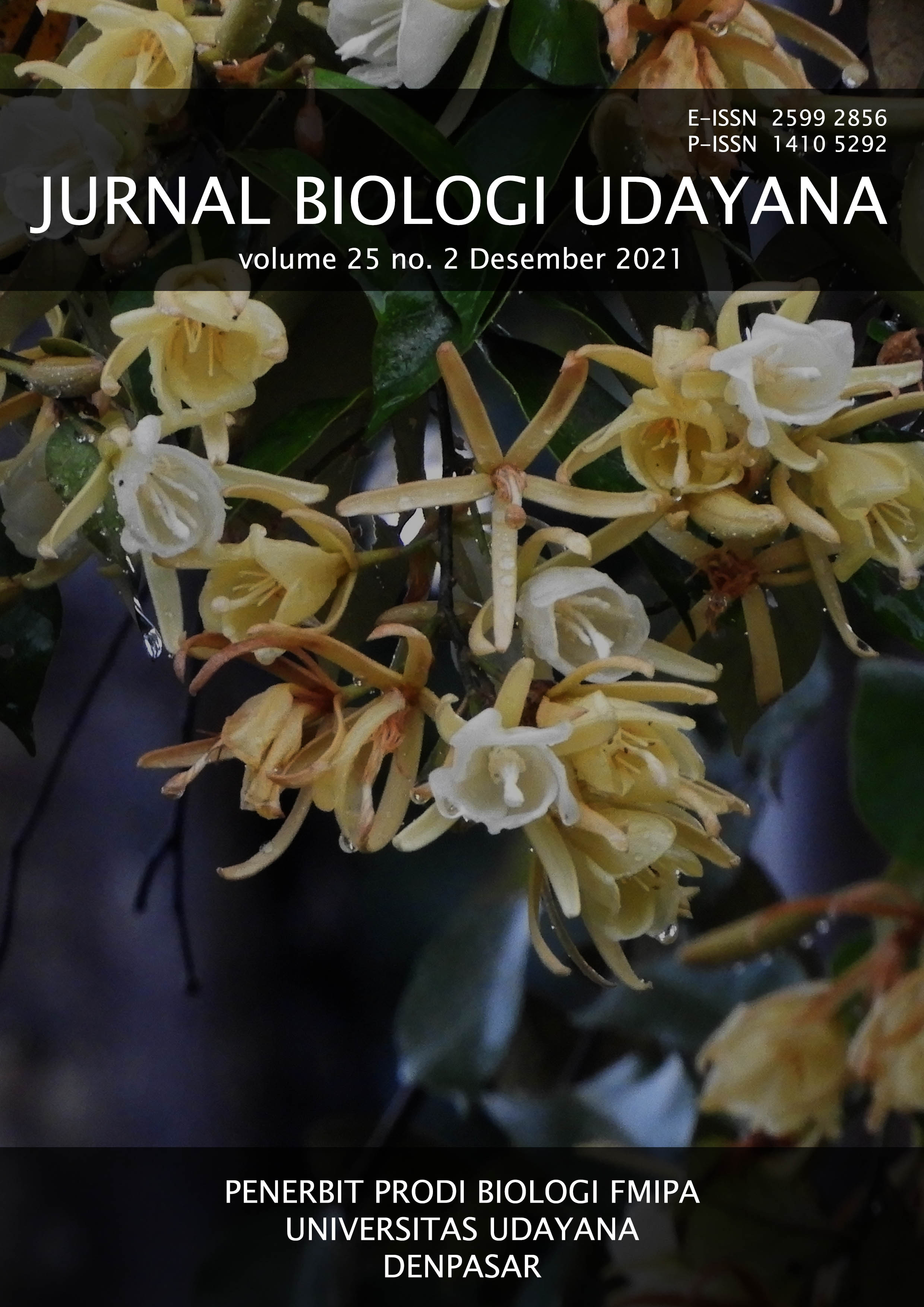Morphological and histological kidney structure in diabetic rats model treated with ethanol extracts of jengkol fruit peel (Archidendron pauciflorum)
Abstract
In a long term, diabetes mellitus (DM) leads to nephropathy due to glomerular hyperfiltration. One of the plant used as a diabetic drug by the community in Karangwangi Village, Cianjur Regency, West Java is the fruit peel of jengkol. Therefore, this study aims to determine the effect of the ethanolic extract of Jengkol fruit peel (EEJFP) toward the morphological and histological structure on the kidney of the diabetic rat model. The method adopted was the Randomized Design (CRD) with 6 treatments namely NC (Carboxyl Methyl Cellulose (CMC) 0.5%), PC (CMC 0.5%), Pb (Glibenclamide 5 mg/kg BW), P1, P2, and P3 (EEJFP 385; 770; and 1,540 mg/kg BW) with 4 replications for 14 consecutive days. Furthermore, the induction of diabetes with streptozotocin dose of 60 mg/Kg BW was performed intravenously in experimental animals except for the NC group. The parameters observed include relative weight, morphological, and histological structure of kidney which include glomerular diameter, Bowman space distance, and percentage of proximal tubular cell necrosis. The non-parametric and parametric data were tested by Kruskal Wallis and ANOVA test as well as Duncan's follow-up test, respectively. The results showed that there was no significant difference in the morphological structure of the kidney between treatment groups. Furthermore, the relative weights of kidney in the PC, Pb, P1, and P3 groups were larger and significantly different compared to NC and P2 also, the histological structure showed that the glomerular diameter (65.43 ± 0.7 m), Bowman space distance (4.19 ± 1.7 µm), and the percentage of proximal tubular cell necrosis (24.6 ± 5.5%) at P2 were not significantly different from NC. Based on this results, it was concluded that EEJFP has no effect on the kidney’s morphological structure, however, it decreases its relative weight and repair the kidney’s histological damage of the diabetic rat model with the optimum dose of 770 mg/kg BW.
Downloads
References
Agoes A. 1991. Pengobatan Tradisional di Indonesia. Medika No.8, Tahun 17: Jakarta.
Anggraini DR. 2008. Gambaran Makroskopis dan Mikroskopis Hati dan Ginjal Mencit Akibat Pemberian Plumbum Asetat. Tesis. Universitas Sumatera Utara Medan.
Aniagu SO, Nwinyi FC, Akumka DD, Ajoku GA, Dzarma S, Izebe KS, Ditse M, Nwaneri PEC, Wambebe C, Gamaniel K. 2005. Toxicity Studies In Rats Fed Nature Cure Bitters. African J. Biotech 4(1): 72-78.
Arsono, S. 2005. Diabetes Melitus sebagai Faktor Risiko Terjadi Gagal Ginjal Terminal. Tesis. Program Pascasarjana Universitas Diponegoro Semarang.
Arumugam G, Manjula P, Paari N. 2013. A Review: Anti Diabetic Medicinal Plants Used For Diabetes Mellitus. Journal of Acute Disease 2(3): 196-200.
Babu PVA, Liu D, Gilbert ER. 2013. Recent Advances in Understanding the Anti-diabetic Action of Dietary Flavonoids. Journal of Nutritional Biochemistry 24(11): 1777-1789.
Djokomuljanto R. 1999. Insulin Resistance and Other Factors in the Patogenesis of Diabetic Nephropathy. Simposium Nefropati Diabetik. Konggres Pernefri.
Furman BL. 2015. Streptozotocin-induced diabetic models in mice and rats. Current Protocols in Pharmacology 70: 1-20.
Hasanoglu. 2001. Efficacy of Micronized Flavonoid Fraction in Healing of Clean and Infected Wounds. Medicina Oral 10(1): 41-44.
Heim, KE, A.R. Tagliaffero and D.J. Bobilya. 2002. Flavonoid Antioxidants: Chemistry, Metabolism and Structure-Activity Relationships. J Nutr Biochem. 13: 572-584.
Hutauruk JE. 2010. Isolasi Senyawa Flavanoida dari Kulit Buah Tumbuhan Jengkol (Pithecellobium lobatum Benth.). Skripsi. Departemen Kimia FMIPA USU Medan.
Kahkonen MP, Hopia AL, Vourela HJ, Rauha JP, Pihlajak, Kujala TS. Heinonen M. 1999. Antioxidant Activity of Extract Containing Phenolic Compounds. J Agric Food Chem. (47): 3954-3962
Kamilawati, F. 2015. Inventarisasi Tumbuhan yang Digunakan Masyarakat sebagai Obat Diabetes di Desa Karangwangi, Kabupaten Cianjur, Jawa Barat. Laporan Kerja Praktek. Universitas Padjadjaran Bandung.
Kemenkes RI. 2018. Riskesdas 2018. Kementerian Kesehatan RI: Badan Penelitian dan Pengembangan.
King GL, Mary RL. 2004. Hyperglycemia-induced Oxidative Stress in Diabetic Complication. Histochem Cell Biol 122: 333–338.
Kumar V, Abbas AK, Aster JC. 2013. Robbins Basic Pathology, Ninth Edition. Elsevier Saunders: Philadelphia.
Kusumajayanty RA. 2007. Gambaran Histomorfologi Ginjal Tikus Putih pada Kondisi Hiperglikemia dan Pemberian Vitamin E. Skripsi. FK Hewan IPB Bogor.
Li, C, Shang D, Wang Y, Li J, Han J, Wang S, Yao Q, Wang Y. 2012. Characterizing the network of drugs and their affected metabolic sub pathways. PLoS ONE 7(10): e47326. DOI: 10.1371/journal.pone.0047326
Malini DM, Madihah J, Kusmoro F, Kamilawati J, Iskandar. 2017. Ethnobotanical Study of Medicinal Plants in Karangwangi,District of Cianjur, West Java. Biosaintifika 9(2): 345-356.
Mikito, Atsuchi,Yamashita, Chiaki, Iwasaki, Yoshio. 1995. A Triterpenoid Saponin, Extraction Thereof and Use To Treat or Prevent Diabetes Mellitus.Muthusamy, S.,
Muchid. A. 2005. Pharmaceutical Care untuk Penyakit Diabetes Mellitus. Bina Kefarmasian dan Alat Kesehatan. Departemen Kesehatan RI: Jakarta.
Nurussakinah. 2010. Skrining Fitokimia dan Uji Aktivitas Antibakteri Ekstrak Kulit Buah Tanaman Jengkol (Pithecellobium jiringa (Jack) Prain.) terhadap bakteri Streptococcus mutans, Staphylococcus aureus dan Escherichia coli. Skripsi. Universitas Sumatera Utara Medan.
Sudoyo AW, Setiyohadi B, Alwi IM, Simadibrata, Setiati S. 2006. Buku Ajar Ilmu Penyakit Dalam Edisi IV, jilid III. Departemen Ilmu Penyakit dalam Fakultas Kedokteran Indonesia: Jakarta.
Syafnir L, Krishnamurti Y, Ilma M. 2014. Uji Aktivitas Antidiabetes Ekstrak Etanol Kulit Jengkol (Archidendron pauciflorum (Benth.) I.C.Nielsen). Prosiding SnaPP2014 Sains, Teknologi, dan Kesehatan 4(1): 65-72.
Sellers RS, Morton D, Michael B, Roome N, Johnson JK, Yano BL, Perry R, Schafer K. 2007. Society of Toxicologic Pathology position paper: organ weight recommendations for toxicology studies. Toxicol. Pathol. 35 (5), 751-755.
Szkudelski, T. 2001. The Mechanism of Alloxan and Streptozotocin Action in β Cells of The Rat Pancreas. Physiol. Res 50: 536-546.
Taneda S, Honda K, Tomidokoro K, Uto K, Nitta K. 2010. Eicosapentaenoic Acid Restores Diabetic Tubular Injury Through Regulating Oxidative Stress and Mitochondrial Apoptosis. Am J Physiol Renal Physiol 299: 1451-1461.
Zafar M, Naqvi SN, Ahmed M, Kaimkhani ZA. 2009. Altered Kidney Morphology and Enzymes in Streptozotocin Induced Diabetic Rats. Int. J. Morphol 27(3): 783-790.
Zafar M, Naqvi SN. 2010. Effects of STZ-Induced Diabetes on the Relative Weights of Kidney, Liver, and Pancreas in Albino Rats: A Comparative Study. Int. J. Morphol 28(1): 135-142.





